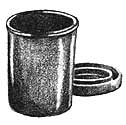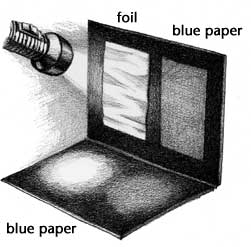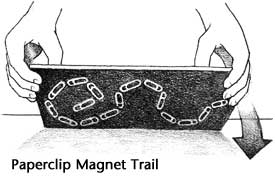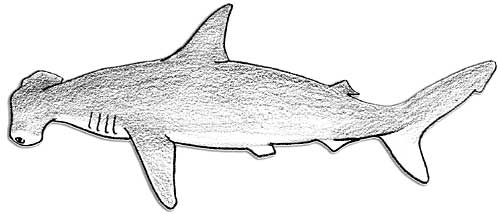|
In the Film
|
Sharks are a vital link in the food chain. They are described as wolves of the sea seeking sick and injured animals. A blue shark is seen feeding on a dead whale. In addition to possessing a keen sense of smell, a shark's awareness of vibration and electroconductivity also serve it well in its search for prey.
|
|
Concept
|
Animals use their senses to locate food and find their way.
|
|
Objective
|
To explore the use of various senses
|
|
Content
|
Science, language arts
|
|
Background
|
Like most animals, sharks rely on their senses to find their way and seek prey. Odor detecting cells are located in the nostrils, which are not used for breathing. Sharks can detect odors in very low concentrations—perhaps even one part per million. Sharks, along with most other fish, possess a lateral line, a series of horizontal pores on the head and sides of the body. These pores are sensitive to vibrations, movement, and pressure changes. Since the deeper the water the darker it is, the sense of vision is more useful at close range or near the surface. However, some sharks have a layer of reflective cells at the back of the eye that enhances their ability to see in dim light. Electroreceptors, mucous-filled pits called ampullae of Lorenzini on the face, respond to the weak electrical fields produced by animals in the sea. These electroreceptors may help sharks find prey at very close range. It is thought that some sharks use magnetic fields found in undersea formations as a guide in migration.
|
|
On the Web
|
Shark School, a part of Kids' Habitat on the San Diego Natural History Museum website is a popular source of information on sharks for children. Shark Parts is especially relevant to this activity; it has a diagram of a shark with explanations about how each part aids in finding, catching, and devouring its prey. From the Shore to the Deep Blue Sea has excellent photographs of the sharks found in the waters off the Baja California peninsula. Shark School also includes FAQs, a glossary, a "Ponder this" question—and games. More advanced readers, may be interested in the Field Guide pages on this website on hammerhead sharks and requiem sharks.
|
![[Materials]](images/materials.gif)
Part A
Smell
14 small containers (film canisters), lemon and peppermint flavoring (or two flavors of your choice), water, 2 medicine droppers, markers, labels, cotton balls
Part B
Sight
6"-square of aluminum foil, 6"-square blue construction paper, 12" x 6" piece of blue construction paper, flashlight, tape
Part C
Magnetic Migration
For each group of students: 10 or12 paper clips, one large bar magnet, 12" x 18" sheet of cardboard, 2 sheets of 12" x 18" paper, pencil, scissors, tagboard, hammerhead shark pattern (above), glue or tape
|
![[Procedure]](images/procedure.gif)
Part A
Smell (whole class)
Students will use their sense of smell to find a feeding ground.
- Label the underside of the containers to identify dilution and flavoring. The labels will be used to self-correctk the sides of the canisters with a color code. This will help students find the correct sequence of dilutions.
- Prepare dilutions.
|

|
Color |
Number of
canisters |
Dilution |
Amount |
| RED |
3 |
#1L |
one dropper of pure lemon flavoring |
| GREEN |
2 |
#2L |
2 drops of dilution #1L, 18 drops of water |
| BLUE |
2 |
#3L |
2 drops of dilution #2L, 18 drops of water |
|
- Repeat the above directions using peppermint flavoring, #1P, #2P, #3P.
This is a minimum number of dilutions and flavorings. You may add more.
- To prevent the possibility of spills, add a small cotton ball to each canister. Cap all canisters until you are ready to set up the game.
- Set up the feeding field.
Place one pure scent (red canister) at each corner of the room. These will be used to introduce the scent. Now position all #2 dilutions (green) in a ring around the room, but inside the pure scent. Place the #3 dilutions (blue) inside that ring. Place the remaining pure scents (red) near the center of the room.
- Play the Feeding Game. Uncover all the canisters. Divide the class into four groups—one group at each corner of the room. Each group starts by smelling the pure scent in their corner. They look at the bottom of the canister to identify themselves as lemon sharks or peppermint sharks. Sharks work their way toward the central feeding ground by searching for their scent from the green dilution to the blue dilution to red (pure scent) in the center of the room. Is it easy to find something using your sense of smell? The weakest dilution, #3, is approximately 1:100. Remember that sharks can smell dilutions of 1:1,000,000.
Note: Preparation and set-up should be done while the class is out of the room.
|

Part B Sight
(small groups)
- Place the large piece of construction paper on a counter, next to a wall. Tape or pin a square of foil and blue paper onto the wall, above the construction paper.
- Darken the room. Shine the flashlight, at an angle, on the foil. Choose an angle that allows the light to reflect from the foil onto the flat paper. Observe the brightness of the reflection. Repeat, shining the light on the blue square next to the foil. Again note the brightness of the reflection.
- Which reflection appears to be brighter? Could you see better in the dark if your eyes had light-reflective cells?
|
|
Part C
Magnetic Migration (small groups)

- Each team prepares a migration route and a shark. Draw a migration route on the cardboard. Glue or tape paper clips along the route. The paper clips represent iron particles imbedded in the ocean floor. Cover the clips with a piece of paper. Use a pencil and your sense of feel to trace the route. Label the paper and the cardboard (on the paper clip side) with your group name. Turn the cardboard over. The migration route is no longer visible. Cut out the hammerhead pattern on tagboard. Glue a strong bar magnet to the underside. Save your map.
- Keep the paper clip side upside down while you exchange migration routes with another team.
- Lay a piece of paper on top of the new cardboard. Hold the paper in place with a few pieces of tape. Use the magnetic hammerhead shark to find the migration trail. Trace the trail on the paperk the map "unknown" trail.
- Compare results. Take your "unknown" map and visit the other groups. Which group made the original migration map that looks like your "unknown" trail? How would magnetic receptors help a shark to find its way?
|
|
Local Connection
Take a sensory walk in your neighborhood. Note what you see, hear, smell, and feel. Which of your senses do you use most?
Key Words
lateral line, reflective, electroreceptors, magnetic, migration
|
|
Continue to Activity 10: Ocean Life Food Web
|
![[Ocean Oasis - Teacher's Guide]](images/bnr-oo-tg.gif)

![[Ocean Oasis - Teacher's Guide]](images/bnr-oo-tg.gif)

![[Shark Sense]](images/sharksense.gif)

![[Materials]](images/materials.gif)
![[Procedure]](images/procedure.gif)
